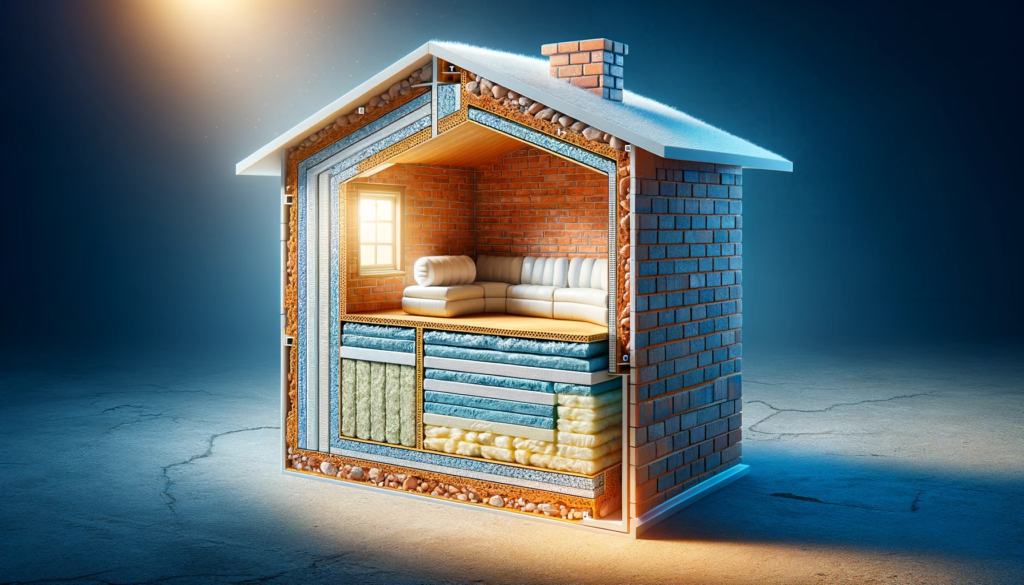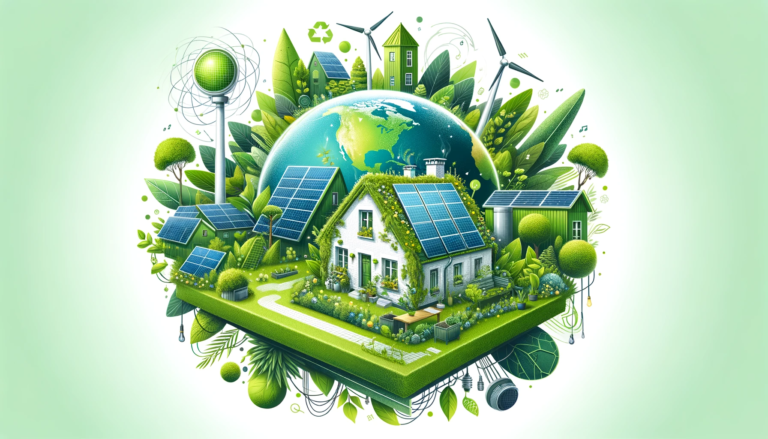Understanding Home Energy Efficiency
When discussing energy efficiency, it's crucial to understand the role it plays in our daily lives. Simply put, energy efficiency refers to using less energy to perform the same tasks - it aids in not just reducing energy waste but also decreasing reliance on non-renewable resources. It's promising that the concept of energy efficiency is gradually gaining ground globally and notably in the residential sector.
At the heart of home energy efficiency lies the concept of home insulation. Insulation can significantly retard heat transfer and control airflow, creating an effective barrier between differing temperature zones. It's essentially like wearing a thermal jacket, but for your home, keeping your abode warm in winters and cool in summers while saving a considerable amount of energy costs. Thus, integrating energy efficiency practices into our homes, particularly home insulation, has become more relevant than ever in today's energy-conscious era.
The Role of Insulation in Energy Conservation
Insulation serves a pivotal function in the realm of home energy efficiency, acting as a protective layer against temperature changes. Good insulation can significantly slow down the transfer of heat, meaning that your house stays warm during the winter and cool during the summer. It optimizes the performance of heating systems and reduces reliance on these systems for comfort, saving not only energy but also slashing costs on energy bills.
Furthermore, insulation isn't solely about maintaining comfortable temperatures inside your home – it can also complement energy-efficient solutions such as LED lighting. For example, LED lighting produces considerably less heat than traditional bulbs. Therefore, less strain is placed on your home's insulation system to manage heat levels. It's evident that when insulation is used in combination with other energy-efficient strategies like LED lighting, it contributes immensely to the promotion of energy efficiency.
| Energy Efficiency Measure | Estimated Energy Savings | Source |
|---|---|---|
| Smart Thermostat Settings | 8-12% on heating, 15% on cooling, up to $50/year | Digital Trends, How-To Geek, The Smart Cave |
| LED Lighting | Up to 90% less energy, average $225/year saved | Department of Energy 1, Department of Energy 2 |
| Home Insulation | 15% on cooling and heating, 11% on total usage | Attainable Home |
| Draught Proofing Windows and Doors | Around £20/year | Love Energy Savings |
| Floorboard Insulation | Around £40/year | Love Energy Savings |
| Wall Insulation | Up to £375/year | Love Energy Savings |
| Loft Insulation | Approximately £250/year | Love Energy Savings |
| Draught Proofing Unused Chimney | Around £15/year | Love Energy Savings |
Smart Thermostat Settings for Maximum Efficiency
Factors like solar panels and glazing significantly impact energy efficiency at home, yet the role of smart thermostat settings in this context remains largely underrated. A smart thermostat, when intelligently set, can optimize energy use and offer significant savings, thus creating an energy-efficient household.
Smart thermostats allow different temperature settings for different times of the day, further enhancing energy efficiency. They can also be controlled remotely via smartphone, allowing adjustments while on the move. Efforts like these, combined with energy-efficient methods such as the use of solar panels and energy-efficient glazing, help homeowners significantly reduce energy consumption and utility bills. As we explore ways to promote an energy-efficient lifestyle, the role of smart thermostat settings therein should not be overlooked.

The Impact of Standby Power on Your Energy Bill
Standby power, commonly referred to as 'vampire power,' is the silent contributor to a significant portion of a household's energy bill. Many modern appliances use some electricity even when they are turned off, which might seem negligible but it can substantially add up if left unchecked. This often-overlooked factor can inhibit the overall efficiency of energy within a home.
A simple solution for increased energy efficiency is draught proofing. It addresses the issue of energy leakages, primarily from the gaps in doors and windows, contributing to maintaining a consistent indoor temperature. Along with draught proofing, being aware and proactive in managing the standby power of appliances can significantly heighten the energy efficiency within a home. Therefore, in order to effectively reduce our energy bills and contribute to a sustainable environment, mindful consumption of power, starting with reducing standby power, is imperative.
External Wall Insulation: A Barrier Against Heat Loss
External wall insulation plays a pivotal role in the achievement of superior energy efficiency in homes and buildings. By acting as a protective sheet, it reduces heat loss through the exterior walls, thus making your heating system work less and saving on energy costs. Without it, all the warmth your system generates could easily leak through the walls and windows, making your home colder and your energy bills steeper.
In terms of efficiency energy, the effect of external wall insulation cannot be overstated. It not only ensures high energy efficiency but also contributes to lower carbon emissions. By keeping the internal heat from escaping and reducing the need for excessive heating, it significantly lowers the use of fossil fuels, thus promoting a cleaner and healthier environment. Ultimately, when it comes to boosting energy efficiency in the most cost-effective way, external wall insulation certainly leads the way.

Flooring Insulation: Keeping the Warmth Underfoot
Flooring insulation is a key ingredient in the recipe for an energy-efficient home. A properly insulated floor keeps the indoor environment comfortable by maintaining consistent temperatures. This process prevents the random exodus of warm or cold air, reducing the strain on your heating system, and ultimately, keeping your energy bill in check.
Not only does this save energy, but it also has a profound impact on the overall efficiency of your home. Contribution towards an energy-efficient home is not just about saving money; it’s also about creating a peaceful, comfortable living space. So, investing in good-quality insulation for your floors can set you on the right path towards energy efficiency.
Roof and Loft Insulation: Capturing Rising Heat
Energy efficiency in homes is gaining priority in today's conversations about sustainability and conservation. The role of a well-insulated roof and loft in capturing rising heat is significantly noteworthy when discussing the mini ecosystem of an energy-efficient home. This form of insulation, which might seem trivial, can help owners of energy efficient homes to trim down their energy expenses by limiting the need for excessive heating in the winter and cooling during the summer months.
Similarly, the impact on the environment is also considerable, given the reduced dependency on energy sources that lead to large carbon emissions. Tailoring the thickness of the insulation to compensate for your geographical location's unique weather patterns is an excellent way to customize your space to ensure maximum energy conservation. Essentially, investing in high-quality roof and loft insulation is not just beneficial, but critical to achieving energy efficiency in homes today.
The Benefits of Solar Panel Installation
Solar panels are a remarkable technological innovation that can significantly boost energy efficiency in homes. They provide a reliable source of power by converting sunlight directly into electricity. This process contributes to energy conservation in two main ways: first, it utilizes a naturally occurring, renewable resource, and second, solar energy is clean, hence, it does not emit harmful substances that would otherwise lead to environmental degradation.
Providing a sustainable solution, solar panel installation can result in long-term savings on energy costs as part of an overall energy efficiency home strategy. This is because once the installation is done, the recurring energy expenses diminish significantly. Moreover, the possibility of selling off surplus energy produced back to the grid, depending on regional regulations, can also lead to an added stream of income. By harnessing the power of the sun, homeowners not only have the chance to become more self-sufficient but also help combat greenhouse gas emissions and global warming in the process.
Upgrading to Energy-Efficient Windows and Doors
When it comes to energy efficiency for home, a notable factor is the role of windows and doors. These elements of the home are so essential yet often overlooked in our pursuit of energy efficiency. A poorly insulated or outdated window or door can serve as a portal for heat to escape during the cold months and an inlet for heat during the hot season. This means that your heating and cooling systems will need to work harder to maintain a comfortable temperature, which can significantly increase energy consumption at home.
Many people may not realize the significant energy savings that can be achieved by investing in energy-efficient windows and doors. These contain advanced technologies, such as double-glazing, low-E glass, and proper sealing, designed to reduce heat transfer and drafts. Revising and perhaps upgrading your home's windows and doors can, therefore, bring significant improvements in energy efficiency at home. Subsequently, it can provide substantial savings on heating and cooling bills, ushering in a greener and more sustainable living environment.
Draught Proofing: Simple Fixes for Big Savings
One of the simplest and most cost-effective ways to boost energy efficiency and save electricity at home is through draught proofing. It consists of blocking unwanted gaps that allow cold air in and warm air out. Be it from doors, windows, or chimneys; these draughts can cause discomfort, inefficient heating, and significant waste of energy. By addressing these issues correctly, homeowners can achieve a more energy-efficient, comfortable home, saving electricity and reducing their carbon footprint.
Sealing draughts might seem trivial, but it's an important part of maintaining a home's energy efficiency. It doesn't require significant monetary or time investment. Simple solutions involve the use of sealant strips, door sweeps, or insulated letterboxes. Even heavier curtains can minimize heat loss through windows during the colder months. Combining all these energy efficiency measures, particularly in older homes where draughts are more likely to occur, can lead to surprisingly big savings on energy bills and help homeowners conserve electricity effectively.
Switching to LED: Bright Ideas for Energy Savings
Switching to LED lights is a relatively simple yet significant step towards remarkable energy efficiency. The reason being, LEDs consume a mere fraction of the electricity required by traditional incandescent bulbs, proving them to be a more sustainable choice. Additionally, LEDs offer a longer service life, reducing the frequency of replacements thereby offering another opportunity for saving on costs. Undeniably, the use of LEDs is rapidly gaining popularity as a solution for saving electricity.
With energy efficiency being the need of the hour, adoption of LEDs becomes a crucial act. Not only does it contribute to a greener environment but also ensures a substantial decrease in electricity bills. Although the upfront costs of LEDs might seem higher compared to traditional lighting, the long-term energy efficiency benefits make the investment worthwhile. Therefore, LEDs are not just a bright idea for illumination but also a brilliant strategy for energy savings.

Low-Carbon Heating Solutions for Modern Homes
Energy efficiency has taken center stage in the design of modern homes, with heating solutions being a major area of focus. A shift towards low-carbon technologies has introduced heating systems that not only reduce our carbon footprint, but also remarkably increase the energy efficiency of our homes. These solutions harness renewable energy sources, coupled with cutting-edge technology, to provide heat in a way that is both effective and environmentally conscious.
Heat pumps are one such solution. They demonstrate excellent energy efficiency by extracting heat from the environment, such as air, ground, or water, and using it to heat homes. Another game-changer in energy-efficient heating is biomass boilers. These systems burn organic materials, like wood pellets or chips, to produce heat. Both of these green methods exemplify how energy efficiency can be incorporated into modern living, lending to a sustainable and cost-effective future. These low carbon solutions are undeniably transforming the heating landscape in modern homes.

Frequently Asked Questions
What is home energy efficiency?
Home energy efficiency refers to the practice of reducing the energy used by household appliances and systems. This can be achieved through insulation, efficient appliances, LED lighting, and other energy-saving methods.
How does insulation contribute to energy conservation?
Insulation plays a crucial role in energy conservation by reducing the amount of heat that escapes from a house in the winter and protecting it from the heat in the summer, thus reducing the need for heating and cooling systems.
How can I use smart thermostat settings for maximum efficiency?
Smart thermostats can be programmed to adjust the temperature automatically at different times of the day, keeping it comfortable when you are home and saving energy when you're not.
What is the impact of standby power on my energy bill?
Standby power, also known as phantom load, refers to the energy that your electronics use when they are turned off but still plugged in. It can significantly increase your energy bill.
Can external wall insulation really help in preventing heat loss?
Yes, external wall insulation acts as a barrier, reducing the amount of heat lost from your home. It can be an effective way to save on heating bills.
How does floor insulation work?
Floor insulation works by reducing the amount of heat that escapes through the floor, keeping your home warm and comfortable.
What are the benefits of solar panel installation?
Solar panels convert sunlight into electricity, reducing reliance on traditional power sources and decreasing greenhouse gas emissions. They can help save on your energy bills and benefit the environment.
Does upgrading to energy-efficient windows and doors make a significant difference?
Yes, energy-efficient windows and doors can help reduce the amount of energy needed to heat or cool your home, resulting in lower energy bills.
What is draught proofing and how can it save energy?
Draught proofing involves sealing off unwanted gaps that let cold air in and warm air out. It's a simple and inexpensive way to reduce your energy use and save money.
How can switching to LED lights help save energy?
LED lights consume less energy and last longer than traditional light bulbs, making them a cost-effective and energy-efficient solution for lighting homes.
What are some low-carbon heating solutions for modern homes?
Low-carbon heating solutions for modern homes include solar heating, heat pumps, biomass boilers, and energy-efficient electric heaters. These solutions reduce carbon emissions and can also help save on energy bills.





Pingback: Thermostat troubleshooting: TOP 13 Problems Best Solutions - techlooters.com